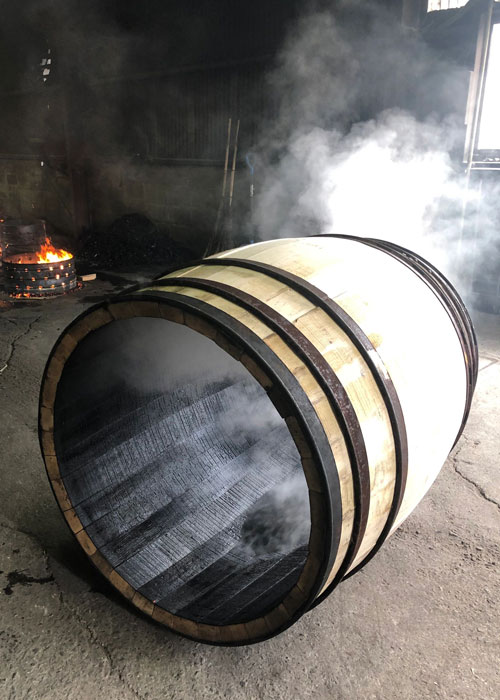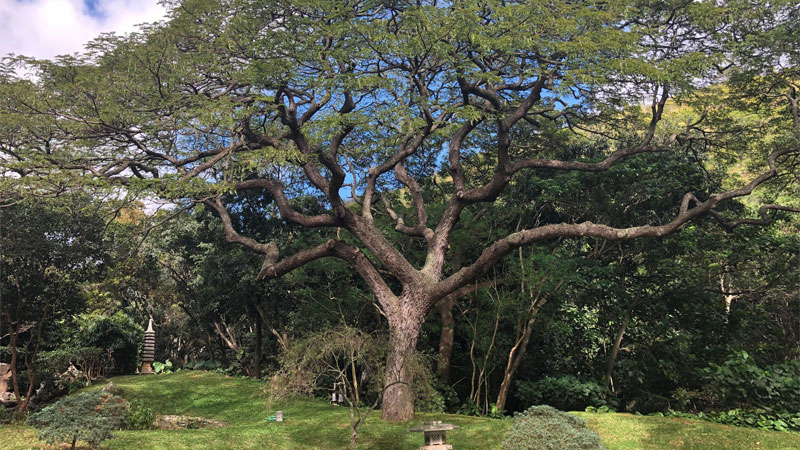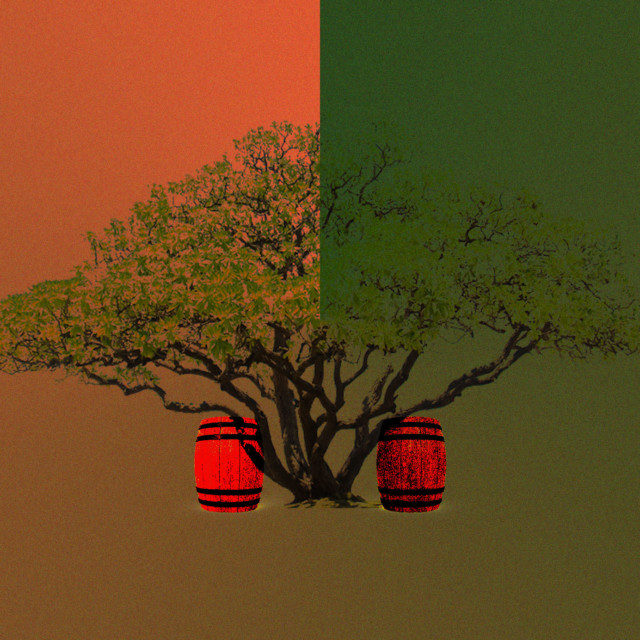On the surface of things, mizunara oak seems like the worst material for making casks that will one day age spirits. The indigenous Japanese species takes at least 200 years to reach maturity before it can be chopped down and made into casks. The wood’s structure is inherently porous and lacks waterproofing oil enzymes, so staves must be cut along the grain to minimize leakage. Along with the species’ stubborn reluctance to grow straight and its high concentration of knots, the process brings wastage and increased cost. Even when cut along the grain, it can take coopers two or three builds, with additional staves added each time, before they’re sure the barrel is watertight. And even then, mizunara casks leak a volume of spirit each year on top of the expected angel’s share. As Jeffrey Karlovitch, master blender of Kaiyo Whisky, puts it, “We lose 3 percent to heaven, and 4 percent to hell.”
All things considered, it’s unsurprising that mizunara oak was ignored by distillers and almost exclusively tapped by Japan’s luxury furniture industry until the mid-20th century. But fast-forward two decades into the 21st century, and things have changed dramatically. Mizunara oak casks hold a place among the most coveted aging vessels in the spirits industry. More than a material for making barrels, mizunara has become a brand: Where distillers have the fortune of resting their spirit in the casks, the mizunara name is emblazoned on bottle labels, often rivaling the producers’ for size and prominence. “It’s almost bigger than brands,” Karlovitch says. “It’s that special.”
The history of using mizunara for spirits casks is one of ingenuity birthed from necessity. The commonly recounted version suggests that after World War II, import restrictions meant Japanese distillers faced a shortage of casks to age their whisky. At the same time, whisky was proving so popular with the occupational armed forces that producers had to find a domestic alternative. And so they turned to their native oak, mizunara.

Whether Japanese distillers fully embraced the quality of mizunara at this point, or viewed it simply as a means to an end, is a topic that draws mixed responses from those now in the industry. But along with the difficulties of working with mizunara, all now agree on the individual qualities that make it so special. To those spirits aging in the casks, the tricky Japanese oak gifts notes of sandalwood, agarwood, and rich coconut, and a defined fruity character. Where American and European oak provide their star turn during their first use, Karlovitch says mizunara only improves with time. “The second and third use: That’s where the magic really happens.”
Those with knowledge on the Japanese whisky industry also agree on the indelible link between mizunara’s surging popularity and the category’s modern success. Liam McNulty, editor of the English-language Japanese drinks publication nomunication.jp, highlights Suntory’s Yamazaki as a notable example. “When Yamazaki started winning all of these awards on the global circuit, people began to look at exactly what set it apart from whiskies made elsewhere in the world,” he says. “Mizunara is one of those reasons.”
Describing mizunara as the one-time “secret weapon” of Japanese whisky, McNulty adds that the secret is now out. No longer the sole reserve of Japanese whisky distillers, mizunara casks have had a hand in gold medal awards for scores of international whiskeys, from Scotland’s Bowmore Mizunara Cask Finish and Chivas Mizunara Blended Scotch Whisky, to America’s Bainbridge Yama Mizunara Cask Single Grain. Pursue bottle shots of each release, and you’ll note the distillery has made the whiskey’s mizunara-aged credentials abundantly clear on their bottle labels.
While critics and connoisseurs are consistent in their praise for mizunara-aged expressions, Bill Thomas, owner of the famed Washington, D.C., whiskey bar Jack Rose, says the fascination with Japanese oak speaks to a bigger trend in whiskey right now. “This is the age of wood,” he says.
If the industry focused more on mash bills between the late ’90s to mid-2000s, Thomas says the spotlight is now on maturation — and he’s not talking about age statements. Whiskey drinkers want to know everything from the species of wood a release was aged in, to how long that wood was seasoned for, how long toasting and charring lasted, and whether the whiskey was aged on land or at sea, by the coast or in the mountains.
With such a microscopic focus on all things aging, “now is the perfect time for mizunara to rise up,” Thomas says.
In some instances, distillers are harnessing the power of mizurana to spark renewed interest in categories other than whiskey. At Cognac Park, Jérôme Tessendier finishes a 4-year Cognac Borderies for six months in the Japanese casks.
The master blender says the house introduced the expression to “communicate with new consumers” by combining the classic profile of Cognac with a notable influence of mizunara. He concedes that in some markets, drinkers view Cognac as an “old style” of spirit left behind by whiskey and innovations like cask-finishing. Though France could be cited as one such market, Tessendier can also point to it as a resounding proof of concept. Cognac Park’s mizunara release now accounts for 75 percent of the house’s sales in its homeland.

As with all commodities deemed both rare and coveted, procuring mizunara casks is far from straightforward. Beyond the governing laws of economics, there are cultural considerations and industrial complications to navigate.
Japan is home to just one independent cooperage, Ariake Sangyo, which is reportedly inundated with orders for mizunara casks from across the world, according to McNulty. (Ariake Sangyo could not be reached for this article.) To secure its raw materials, the small, 35-person operation must compete at auction with the in-house cooperages of large distilleries (Suntory, Nikka, and Chichibu) as well as the luxury furniture trade. “I understand the auctions are quite competitive,” McNulty says. Given the lengthy maturation periods of premium Japanese whisky, and mizunara’s ability to improve with age, international distillers can forget buying used barrels.
Still, that hasn’t stopped many, like Tessendier, from trying and succeeding. When Ireland’s Glendalough Distillery decided to release the country’s first mizunara-finished whiskey, founder and national brand ambassador Donal O’Gallachoir jetted out to Hokkaido on a wing and a prayer. Armed with only a tentative introduction to the Ariake cooperage, he and his colleagues took time to tour the facility and build a relationship with the company. “That was very much the backbone of us being able to make an agreement with them,” he says.
O’Gallachoir recalls the attention to detail and level of craft that he witnessed at the cooperage. As for the final release, a 13-year-old Irish single malt finished for just shy of one year in the prized mizunara oak, all the effort paid off: “It was the type of whiskey for solving all the world’s problems at 2 o’clock in the morning,” O’Gallachoir says.
Alexander Stein, founder of the German gin brand Monkey 47, ran into similar difficulties when purchasing his mizunara barrels — all five of them, for which he is very grateful. “It’s not [a case of] put your money on the table and you get supplied,” he says. “[The cooperage] wants to know what you’re going to do with the barrels.”
In this case, the casks would be used for the 2020 edition of Monkey 47’s Distiller’s Cut series, with the gin resting an average of 180 days in oak. With the exclusive annual release already a collector’s item among gin connoisseurs, the mizunara edition would have sold out regardless, which is perhaps why the word only appears in small font on the bottle’s back label.
Asked whether he thinks mizunara has indeed become a “brand,” Stein is more hesitant to agree than others, noting that it’s probably only the case inside the bubble of industry professionals and spirits aficionados. It’s a worthy reminder that, for all its marketing might, mizunara’s real magic is what it brings to a spirit.
Still, for those in the know, the appeal is undeniable.
When Jack Rose’s Thomas released a recent mizunara-aged barrel pick at his bar — bought from Karlovitch’s Kaiyo — he says “people went freaking bananas for it.” No doubt, the rarity of Japanese barrel picks sparked interest in the whiskey, Thomas says. But the real appeal of the release was how accurately it served the “Wikipedia-page” profile of the oak. It delivered the magic of mizunara.
“The lucky ones bought it on the first day and came back and bought second and third bottles while we still had them,” he says. “When even the staff is buying the bottles to take home, that’s a sign.”
